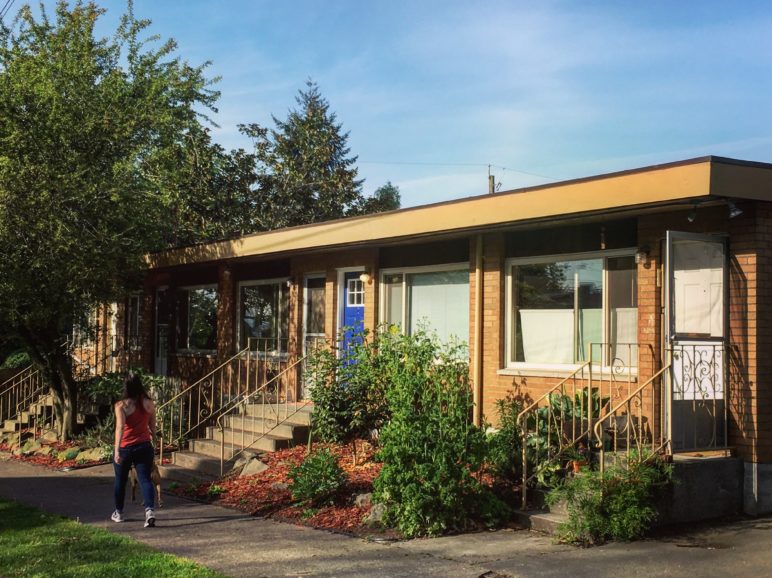The CARES Act’s unemployment insurance, paycheck protection loans, and stimulus checks shoveled over $1 trillion into American’s wallets from April through July. That aid provided critical relief for renters, who’ve been slammed disproportionately by job losses and were all too often already crushed under high rents even before the pandemic.
If Congress can’t pass another coronavirus relief package well before the November 3 election, it likely won’t happen until next year. And that would leave millions of cash-strapped tenants without federal support for six months or more—a recipe for an unprecedented renter catastrophe. By one worst case estimate, 30 to 40 million renters risk eviction from their homes.
Over recent weeks, however, neither US Census surveys nor industry tracking has detected any spike in unpaid rent. The main reason? It’s too soon. Struggling renters have been eking out ways to pay the bills, tapping into savings, selling assets, or running up debt. But that can’t last.
The widely feared explosion of evictions also has not yet hit. That’s largely because a patchwork of emergency eviction bans has protected most US renters during much of the pandemic. In September, the Centers for Disease Control banned evictions nationally through the end of the year.
Meanwhile economic indicators portend a stalled recovery. And for renters, that sets up a ticking time bomb. That is, unless Congress steps up and enacts aid that includes support for renters. The window of opportunity before the election is closing fast but it’s still open a crack.
The CARES Act successfully held off widespread renter misery, and also provided life support for the whole US economy. Congress can repeat that success by re-authorizing unemployment benefits and adding targeted assistance for renters, for example the $100 billion slated in the HEROES Act, passed by House Democrats in May.
But if Congress doesn’t come through, the eviction bans will inevitably expire. Renters will be on the hook to pay back their owed rent on top of their ongoing regular rent. And that’s when the eviction bomb will finally explode.
Read on for a closer look at the current status and future prospects for US renters.
The expiration of the CARES Act left a huge hole in the COVID safety net
Between March 29 and August 1, the CARES Act’s $600 per week supplemental unemployment insurance (UI) provided $211 billion. Up until it expired on August 8, the Paycheck Protection Program (PPP) granted a total of $525 billion in forgivable loans to businesses that committed to retaining employees. And the one-time stimulus checks granted in April totalled some $290 billion.
Combined, that’s $1 trillion over four months. Annualized, it’s equivalent to a whopping 15 percent of the 2019 total US GDP of $21 trillion. Economists credit the federal aid for raising US personal income by 10.5 percent in April, even in the midst of skyrocketing unemployment.
Renters disproportionately hold lower paying jobs, so the $600 per week extra UI was especially effective in helping them stay current on rent (see our estimate of UI benefits reaching renters). Meanwhile, PPP kept renters on payrolls.
Last month, President Trump issued an executive order for stopgap $300 per week UI, allocating $44 billion to cover about five weeks. Accessing the funds required state bureaucratic wrangling that delayed payments. As of mid-September, 49 states were approved and 21 states were sending out checks. Idaho and Washington have begun processing payments, while Alaska and Oregon plan to start in the coming weeks.
Some state and local governments have enacted rental assistance, but invariably the level of funding falls far below the need. For example, King County, which encompasses Seattle, has $41 million of CARES Act funding for renters. The program will bring aid to as many as 10,000 low-income households, but that’s only 3 percent of King County’s total 370,000 renter households. Each household would receive an average of $4,100, enough to cover perhaps three months’ rent.
In short, the CARES Act aid worked. It kept people securely housed and stabilized the economy more broadly. But the pandemic and recession are still with us. On top of that, without federal help, tax-starved state and local governments will soon be forced to cut both programs and workforces, accelerating the downward economic spiral.
MOST RENTERS APPEAR TO BE KEEPING UP—SO FAr
The Census Pulse Survey, created to track the pandemic, asks two questions about the payment status of renters: Are they caught up on rent? And, do they expect to be able to pay next month’s rent? In surveys between April 23 and September 14, neither question has revealed any trend that clearly indicates whether things have been getting worse or better for renters as the pandemic progressed. And there is no pre-COVID baseline data to separate out the impact of pandemic.
In the most recent survey taken from September 2 – 14, the fraction of US renters “not caught up” on rent rose to 16.5 percent, up from 14.4 percent two weeks prior. It’s only two data points, but it’s the strongest indication yet of a negative trend for renters. Unfortunately, prior surveys worded the question differently so the older data aren’t comparable.
The share of US renters likely to miss a future rent payment (those with “no” or “low” confidence they can pay, or who will defer payment) came in at 26 percent for both of the two most recent surveys. That fraction is the lowest yet observed (previously it ranged from 28 to 34 percent), oddly, even though renters had faced the loss of federal UI benefits for up to a month and a half at that point. Cascadian state and metro-level data are similarly inconclusive.
The Census data also revealed large racial disparities that stayed fairly consistent over the four months of surveys. Averaging all 14 surveys, the percent likely to miss a future rent payment was 21 for whites, 28 for Asians, 42 for Blacks, and 43 for Hispanics.
The National Multifamily Housing Council (NMHC) conducts a weekly survey of 11.4 million “professionally managed apartment units across the country.” During the pandemic, their results have shown only slight reductions in the fraction of tenants who’ve made full or partial rent payments, compared with the year prior. For the week ending September 20, that fraction was 90.1 percent, which is 1.7 percentage points lower than the same week in 2019. That corresponds to 192,936 fewer US households keeping up with rent. Of the pandemic months so far, April showed the biggest drops in full/partial rent payments, ranging from 3 to 5 percentage points.
Analysts at RealPage attribute the NMHC data’s unexpectedly high rate of rent payment during the pandemic to the “effectiveness of resident background screening systems in use at nearly all professionally-managed communities.” In other words, the rentals NMHC tracks skew toward higher-income tenants who’ve had better job security during the pandemic.
The cheaper housing not tracked by NMHC likely has more rent delinquency because those tenants tend to have the kinds of low-paying jobs that the pandemic decimated. That includes mom and pop landlords that offer more modest, affordable rentals, as well as subsidized low-income housing. In April, one Seattle affordable housing provider reported a delinquency rate of 21 percent, way up from the 2 to 3 percent typical of normal times. Another Seattle provider is currently projecting 15 percent unpaid rent for the coming months, up from around 10 percent during the pandemic so far, and compared with just 3 percent in 2019.
Since April, ApartmentList has conducted surveys during the first week of the month to track the fraction of renters that have missed or made only partial rent payments. The results have not revealed any significant upward trend as the pandemic progressed, and there’s no pre-pandemic data with which to compare. In September the fraction was 32 percent, down from 34 percent in August.
In renter surveys conducted by listing firm Avail, 31 percent respondents said they were not able to pay their full rent in August, compared with 25 percent in July. While that indicates an upward trend, none of the other data sources discussed above corroborate it.
The lack of evictions is a lull before the storm
The economic devastation caused by the coronavirus shutdowns led housing advocates to warn of a potential explosion in evictions. But best available data don’t show it yet. For the 17 US cities tracked by the Eviction Lab, all but Milwaukee have seen monthly eviction filings during the pandemic at well below the rates typical of normal times. (In Milwaukee, evictions rose above the historic average in June and July, and then dropped back well below it in August and September.)
One reason that evictions have not surged is many governments banned them. From April through July, the CARES Act’s national eviction ban protected renters in housing financed by federal loans or programs, roughly a quarter of US rentals. Throughout most of the US, most major cities and many states also enacted eviction moratoriums, though often temporary ones. In most cases the emergency bans apply only to unpaid rent, so landlords can still evict tenants for other legal reasons. Since mid-March, the Eviction Lab has tracked more than 50,000 eviction filings in its 17 cities.
On September 4 the Centers for Disease Control (CDC) enacted a national eviction ban that covers all rental housing through 2020. To be protected, renters must notify landlords in writing that they:
- Made “best efforts” to access government rental assistance
- Have an income that doesn’t exceed $99,000 (or $198,000 for couples)
- Can’t pay rent due to loss of income or high medical costs
- Are making “best efforts” to pay rent partially
- Would likely become homeless or would move into congregate housing if evicted
Some at-risk renters—especially those with language barriers—may have trouble navigating the process, and landlords can challenge their declarations in court. Despite the new federal ban, Popular Information reports that “across the country, private equity firms and other corporate landlords have filed more than 1,500 new eviction cases since September 1.”
Another reason for lower than expected evictions is that landlords may be motivated to work out compromises with their tenants. In a recession with high unemployment, a tenant that’s making partial payments may be better than no tenant at all. In Avail’s August renter survey, 15 percent of respondents reported they had rent deferments or an extended payment plan.
Why hasn’t the renter time bomb detonated yet?
Several factors are contributing to the lack so far of observed rent delinquency so far. For one thing, it has only been eight weeks since federal UI payments ended, and six weeks since PPP stopped accepting loan applications. For most renters, forgoing the rent payment is a last resort.
In mid-June, the Census Pulse Survey began asking renters how they are coming up with rent. The combined share of US renters paying with credit cards and loans, relying on savings and selling assets, or borrowing from friends or family, has trended consistently upward. It rose to a high of 83 percent for the second half of August, from a low of 63 percent when the question was first asked.
In September, ApartmentList added a similar question to their survey, and 63 percent of respondents said they had drawn on savings, borrowed, or sold assets to keep up with rent. The minimal rise in unpaid rent in NMHC’s September data led their analysts to conclude that “it remains clear that many apartment residents continue to prioritize their housing obligations and that apartment owners and operators remain committed to meeting them halfway with creative and nuanced approaches.”
Of the renters who responded to Avail’s August survey asking what actions they’ve taken to cover rent, 42 percent pulled from savings; 38 percent borrowed from family and friends, and 15 percent used credit cards. In surveys by Clever Real Estate, the fraction of Americans reporting they had increased their credit card debt to cover expenses rose to 18 percent in September, up from 8 percent in April.
The above-mentioned emergency measures available to renters have a limit, of course. Savings run dry, credit cards hit their max, friends and family run out of patience, and landlords can’t defer rent forever. And these emergency steps can build up to bigger economic burdens later.
Another dynamic that may be masking impacts is when renters who can no longer afford their own rent resort to moving in with family or friends. Such people would not show up in the numbers for unpaid rent or evictions. Data suggest household consolidation has been proliferating during the pandemic. July US Census data show the share of 18- to 20-year olds living with their parents has risen to 52 percent, surpassing the previous high set during the Great Depression. In a June Pew Research Center survey of the pandemic’s effects on moving, 6 percent of respondents said someone moved into their household (3 percent said they moved themselves, and 14 percent said that they know someone else who moved).
A final speculation: the new federal eviction ban will escalate rent delinquency. Most US renters now have more certainty than ever before that they can’t be evicted. Some may hope to delay payment and catch up when times get better, while others may only want to put off the inevitable, knowing they’ll never be able to pay. Either way, it only sets back the timer on the eviction bomb.
Time is running out for Congress to defuse a nationwide eviction bomb
Congress already knows how to defuse the time bomb threatening renters. They’ve already done it once before with the CARES Act (cut the green wire, not the red one!). And they can do even better this time around by adding the $100 billion of rental assistance that House Democrats passed months ago.
But as of today, there is no formal stimulus proposal on the table, and a chasm remains between what Senate Republicans and House Democrats want in a bill. The imminent partisan fight over the supreme court justice nomination process further dims the prospects for action before the election.
If Congress can’t make it happen in the next week or two, chances are slim to none for the rest of the year. In which case the inevitable outcome is an unprecedented eviction explosion that will tear apart the lives of millions of renters, their families, and their communities.










